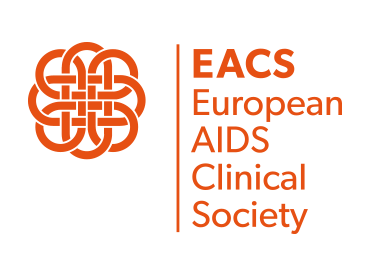Welcome to Prestigio Registry platform
Abstract from EACS 2023 - Fri Oct 20 2023

Risk of virological failure after drug burden reduction in non-viremic people with 4-class drug-resistant HIV: data from the PRESTIGIO Registry
Purpose: To evaluate the risk of virological failure (VF) after drug burden reduction (DBR) in non-viremic people living with documented 4-class drug-resistant HIV (4DR-PLWH).
Methods: Cohort study on 4DR-PLWH from the PRESTIGIO Registry, on antiretroviral therapy (ART), with stable viral suppression. In case of ART switch (defined as DBR when number of drugs or dosage was reduced for any reason), only the first change was considered. Follow-up accrued from the second VL<50 copies/mL (baseline) until VF [2 consecutive VLs≥200 (VF200) or 50 copies/mL (VF50)] or the second ART switch or the last available VL measurement. Time to VF200/VF50 estimated using the Simon-Makuch method. Cox regression model applied to assess predictors of risk of VF200; type of ART switch considered as time-dependent variable.
Results: Overall, 166 4DR-PLWH evaluated (Table1). After a median follow-up of 3.75 (IQR=2.26-5.59) years, 34 (20.5%) individuals had VF200. DBR occurred in 51 (30.7%) PLWH after 1.98 (0.6-3.42) years [10/51 (19.6%) had VF200], other ART switches in 28 (16.9%) after 1.82 (1.09-3.32) years [4/28 (14.3%) had VF200]. Risk of VF200 tended to be higher after DBR (Figure1).
Fifty-one (30.7%) PLWH had VF50; DBR in 45 (27.1%) individuals [8/45 (17.8%) had VF50], other ART switches in 27 (16.3%) [8/27 (29.6%) had VF50]. Compared to no ART change, DBR did not lead to a higher risk of VF50, differently from other switches (Figure2).
At multivariable analysis, a higher risk of VF200 was significantly associated with a lower baseline CD4+/CD8+, but with neither DBR nor other ART switches (Table2).
Conclusions: Drug burden reduction showed a potential impact on the risk of VF ≥200 copies/mL in non-viremic 4DR-PLWH. Baseline immunological impairment could also affect the risk of VF. Investigation of new tools to identify 4DR-PLWH at higher risk of VF after simplification is required, given the critical need for DBR in this fragile population.
Key Words: HIV; multidrug resistance; antiretroviral therapy; simplification; virological failure.
Category: B1 (Clinical science – Antiretroviral therapy)
Subcategory: HIV drug resistance
Table 1.
| Baseline characteristics | Overall (n=166) |
No ART change (n=87) |
Drug burden reduction (n=51) |
Other ART switches (n=28) |
P-value |
|---|---|---|---|---|---|
| Age (years), median (IQR) |
51.3 (46.8-56.3) |
52.7 (47.1-57.2) |
50.2 (46.1-56.5) |
50.4 (47.8-54.8) |
0.48 |
| Female gender, n (%) |
47 (28.3%) |
23 (26.4%) |
17 (33.3%) |
7 (25.0%) |
0.63 |
| ART duration (years), median (IQR) |
19.9 (16.0-23.0) |
21.3 (16.5-23.9) |
19.8 (15.7-21.8) |
19.0 (16.2-21.1) |
0.07 |
| CD4+/CD8+ ratio, median (IQR) |
0.48 (0.31-0.71) |
0.49 (0.32-0.73) |
0.48 (0.32-0.60) |
0.54 (0.27-0.83) |
0.52 |
| Number of ongoing antiretroviraldrugs, n (%) |
3.0 (3.0-4.0) |
3.0 (2.0-4.0) |
3.00 (3.00-4.50) |
3.0 (3.0-4.0) |
0.01 |
| PI-containing regimen, n (%) |
146 (88.0%) |
76 (87.4%) |
46 (90.2%) |
24 (85.7%) |
0.81 |
| INSTI-containing regimen, n (%) |
147 (88.6%) |
79 (90.8%) |
45 (88.2%) |
23 (82.1%) |
0.45 |
| Entry inhibitor (MVC, T20, FTR and/or IBA) -containing regimen, n (%) |
57 (34.3%) |
24 (27.6%) |
23 (45.1%) |
10 (35.7%) |
0.11 |
| Genotypic susceptibility score, median (IQR) |
2.0 (1.5-2.0) |
2.0 (1.5-2.0) |
2.0 (1.5-2.12) |
2.0 (1.5-2.5) |
0.36 |
Table 2.
| Characteristics | Category | Adjusted Hazard ratio of VF200 (95% confidence interval) |
P-value |
|---|---|---|---|
| DBR | Yes vs No | 1.95 (0.73-5.17) | 0.17 |
| Other ART switches | Yes vs No | 1.92 (0.56-6.61) | 0.30 |
| Gender | Female vs Male | 0.67 (0.27-1.63) | 0.37 |
| Age at baseline | Per 1-year older | 0.96 (0.91-1.01) | 0.09 |
| CD4+/CD8+ ratio at baseline | Per 0.1 higher | 0.84 (0.72-0.99) | 0.03 |
| ART duration at baseline | Per 1-year higher | 0.97 (0.92-1.02) | 0.26 |


